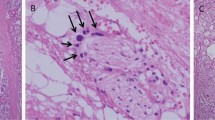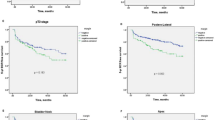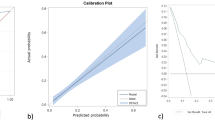Abstract
Despite recent Level 1 evidence on the benefits of adjuvant radiotherapy for locally advanced prostate cancer (PCa), the timing and decision to administer adjuvant radiotherapy post-radical prostatectomy (post-RP) remains debatable, particularly for patients with focal extraprostatic extension (EPE) and/or focal positive surgical margins (PSMs). In this study, we assess the utility of detailed pathological assessment of EPE and PSM, as this may influence the criteria for instituting adjuvant radiotherapy. A total of 148 RP cases (1993–2001) were identified retrospectively as having EPE and/or PSM. All slides were re-reviewed, incorporating recent proposals by the Collage of American Pathologists (CAP) for the reporting of EPE and PSM, and correlated with clinical data. Both EPE and PSM were found to be independent predictors of biochemical failure (BCF); however, only EPE was associated with metastasis and death. BCF was also more likely to be associated with cases that had non-focal EPE than focal EPE. Similarly, non-focal PSM cases had a significantly higher risk of BCF than focal cases. Our study confirms the value of detailed pathological assessment of EPE and PSM post-RP. The results support the concept of selective adjuvant radiotherapy in patients with EPE and PSM, based on focality and extent.
This is a preview of subscription content, access via your institution
Access options
Subscribe to this journal
Receive 4 print issues and online access
$259.00 per year
only $64.75 per issue
Buy this article
- Purchase on Springer Link
- Instant access to full article PDF
Prices may be subject to local taxes which are calculated during checkout



Similar content being viewed by others
References
European Organization for Research and Treatment of Cancer Bolla M van Poppel H, Collette L, van Cangh P, Vekemans K, Da Pozzo L et al. Postoperative radiotherapy after radical prostatectomy: a randomised controlled trial (EORTC trial 22911). Lancet 2005; 366: 572–578.
Thompson IM, Tangen CM, Paradelo J, Lucia MS, Miller G, Troyer D et al. Adjuvant radiotherapy for pathologically advanced prostate cancer: a randomized clinical trial. JAMA 2006; 296: 2329–2335.
Wiegel T, Bottke D, Steiner U, Siegmann A, Golz R, Storkel S et al. Phase III postoperative adjuvant radiotherapy after radical prostatectomy compared with radical prostatectomy alone in pT3 prostate cancer with postoperative undetectable prostate-specific antigen: ARO 96-02/AUO AP 09/95. J Clin Oncol 2009; 27: 2924–2930.
Thompson IM, Tangen CM, Paradelo J, Lucia MS, Miller G, Troyer D et al. Adjuvant radiotherapy for pathological T3N0M0 prostate cancer significantly reduces risk of metastases and improves survival: long-term followup of a randomized clinical trial. J Urol 2009; 181: 956–962.
Catton C . The role of radiation therapy in prostate cancer after radical prostatectomy: when and why? Curr Opin Support Palliat Care 2010; 4: 135–140.
Srigley JR, Humphrey PA, Amin MB, Chang SS, Egevad L, Epstein JI et al. Protocol for the examination of specimens from patients with carcinoma of the prostate gland. Arch Pathol Lab Med 2009; 133: 1568–1576.
Epstein JI, Amin M, Boccon-Gibod L, Egevad L, Humphrey PA, Mikuz G et al. Prognostic factors and reporting of prostate carcinoma in radical prostatectomy and pelvic lymphadenectomy specimens. Scand J Urol Nephrol Suppl 2005; 216: 34–63.
Epstein JI, Carmichael MJ, Pizov G, Walsh PC . Influence of capsular penetration on progression following radical prostatectomy: A study of 196 cases with long-term followup. J Urol 1993; 150: 135–141.
Wheeler TM, Dillioglugil O, Kattan MW, Arakawa A, Soh S, Suyama K et al. Clinical and pathological significance of the level and extent of capsular invasion in clinical stage T1-2 prostate cancer. Hum Pathol 1998; 29: 856–862.
Chuang AY, Nielsen ME, Hernandez DJ, Walsh PC, Epstein JI . The significance of positive surgical margin in areas of capsular incision in otherwise organ confined disease at radical prostatectomy. J Urol 2007; 178: 1306–1310.
Stephenson AJ, Wood DP, Kattan MW, Klein EA, Scardino PT, Eastham JA et al. Location, extent and number of positive surgical margins do not improve accuracy of predicting prostate cancer recurrence after radical prostatectomy. J Urol 2009; 182: 1357–1363.
Epstein JI, Sauvageot J . Do close but negative margins in radical prostatectomy specimens increase the risk of postoperative progression? J Urol 1997; 157: 241–243.
Eastham JA, Kuroiwa K, Ohori M, Serio AM, Gorbonos A, Maru N et al. Prognostic significance of location of positive margins in radical prostatectomy specimens. Urology 2007; 70: 965–969.
Karakiewicz PI, Eastham JA, Graefen M, Cagiannos I, Stricker PD, Klein E et al. Prognostic impact of positive surgical margins in surgically treated prostate cancer: Multi-institutional assessment of 5831 patients. Urology 2005; 66: 1245–1250.
Shikanov S, Song J, Royce C, Al-Ahmadie H, Zorn K, Steinberg G et al. Length of positive surgical margin after radical prostatectomy as a predictor of biochemical recurrence. J Urol 2009; 182: 139–144.
Babaian RJ, Troncoso P, Bhadkamkar VA, Johnston DA . Analysis of clinicopathologic factors predicting outcome after radical prostatectomy. Cancer 2001; 91: 1414–1422.
Ochiai A, Sotelo T, Troncoso P, Bhadkamkar V, Babaian RJ . Natural history of biochemical progression after radical prostatectomy based on length of a positive margin. Urology 2008; 71: 308–312.
Saether T, Sorlien LT, Viset T, Lydersen S, Angelsen A . Are positive surgical margins in radical prostatectomy specimens an independent prognostic marker? Scand J Urol Nephrol 2008; 42: 514–521.
van Oort IM, Bruins HM, Kiemeney LA, Knipscheer BC, Witjes JA, Hulsbergen-van de Kaa CA . The length of positive surgical margins correlates with biochemical recurrence after radical prostatectomy. Histopathology 2010; 56: 464–471.
Epstein JI, Pizov G, Walsh PC . Correlation of pathologic findings with progression after radical retropubic prostatectomy. Cancer 1993; 71: 3582–3593.
Cheng L, Darson MF, Bergstralh EJ, Slezak J, Myers RP, Bostwick DG . Correlation of margin status and extraprostatic extension with progression of prostate carcinoma. Cancer 1999; 86: 1775–1782.
Epstein JI, Allsbrook WC, Amin MB, Egevad LL . The 2005 international society of urological pathology (ISUP) consensus conference on gleason grading of prostatic carcinoma. Am J Surg Pathol 2005; 29: 1228–1242.
Nielsen ME, Trock BJ, Walsh PC . Salvage or adjuvant radiation therapy: counseling patients on the benefits. J Natl Compr Canc Netw 2010; 8: 228–237.
Lake AM, He C, Wood Jr DP . Focal positive surgical margins decrease disease-free survival after radical prostatectomy even in organ-confined disease. Urology 2010; 76: 1212–1216.
Swindle P, Eastham JA, Ohori M, Kattan MW, Wheeler T, Maru N et al. Do margins matter? the prognostic significance of positive surgical margins in radical prostatectomy specimens. J Urol 2008; 179: S47–S51.
Author information
Authors and Affiliations
Corresponding authors
Ethics declarations
Competing interests
The authors declare no conflict of interest.
Rights and permissions
About this article
Cite this article
Chan, S., Garcia, F., Chin, J. et al. The clinical significance of in-depth pathological assessment of extraprostatic extension and margin status in radical prostatectomies for prostate cancer. Prostate Cancer Prostatic Dis 14, 307–312 (2011). https://doi.org/10.1038/pcan.2011.15
Received:
Revised:
Accepted:
Published:
Issue Date:
DOI: https://doi.org/10.1038/pcan.2011.15
Keywords
This article is cited by
-
Revisiting extraprostatic extension based on invasion depth and number for new algorithm for substaging of pT3a prostate cancer
Scientific Reports (2021)
-
Digital versus light microscopy assessment of extraprostatic extension in radical prostatectomy samples
Virchows Archiv (2019)
-
Digital versus light microscopy assessment of surgical margin status after radical prostatectomy
Virchows Archiv (2018)
-
Do robotic prostatectomy positive surgical margins occur in the same location as extraprostatic extension?
World Journal of Urology (2014)
-
Characteristics of modern Gleason 9/10 prostate adenocarcinoma: a single tertiary centre experience within the Republic of Ireland
World Journal of Urology (2014)



